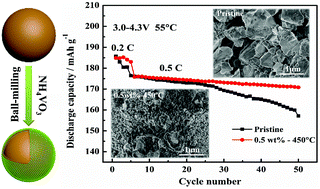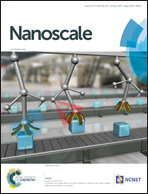Revealing the role of NH4VO3 treatment in Ni-rich cathode materials with improved electrochemical performance for rechargeable lithium-ion batteries†
Abstract
Although Ni-rich layered oxides are considered a candidate of next-generation cathode materials, their inherent properties, such as surface lithium residues and structural destruction, cause detrimental electrochemical performance, especially at elevated temperatures. Here, a facile ball-milling method is proposed to remove the lithium residues and enhance the electrochemical performance of LiNi0.6Co0.2Mn0.2O2. After NH4VO3 treatment, a lithium ion-conductive Li3VO4 coating layer is found on the LiNi0.6Co0.2Mn0.2O2 surface at heat-treatment temperatures of 300 and 450 °C, with a small part of vanadium ions diffusing into the surface lattice. When the temperature surpasses 600 °C, almost all vanadium ions dope into the bulk structure. The complex relationships between the post-sintering temperature and surface structure and their impact on electrochemical properties are discussed in detail. Electrochemical tests show that 0.5 wt% NH4VO3 treated LiNi0.6Co0.2Mn0.2O2 at 450 °C exhibits much improved cycling stability (96.1% cycling retention at 0.5C after 100 cycles and 97.2% after 50 cycles at 55 °C), rate capability (117.0 mA h g−1 at 5C), and storage property (4683 ppm lithium residue amount after storing in air for 7 days). Such superior performance is ascribed to the Li3VO4 coating layer that inhibits the electrolyte decomposition and helps create a stable and thinner cathode–electrolyte interface, resulting in decreased interfacial resistance. In addition, this coating layer suppresses internal micro-stress and phase transformation from a layered to spinel and rock-salt structure, which increases the structural integrity of LiNi0.6Co0.2Mn0.2O2 during repeated charge–discharge cycling.



 Please wait while we load your content...
Please wait while we load your content...